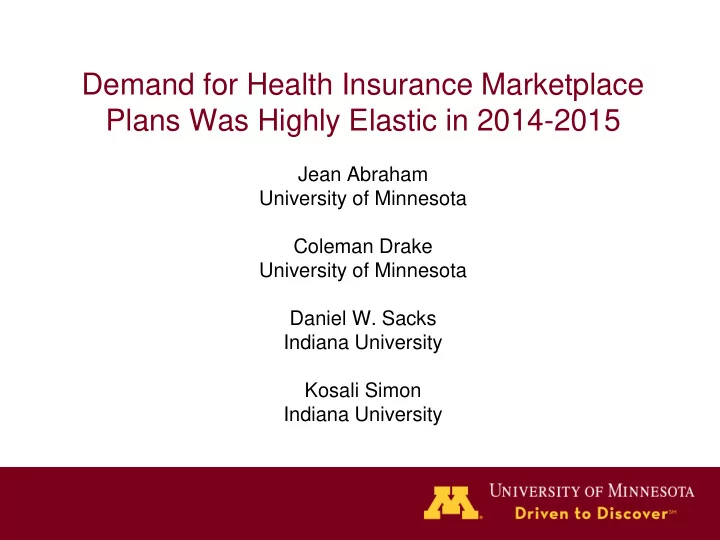

Demand for Health Insurance Marketplace Plans Was Highly Elastic in 2014-2015 Jean Abraham University of Minnesota Coleman Drake University of Minnesota Daniel W. Sacks Indiana University Kosali Simon Indiana University
Introduction • Individual market as a residual market • ACA created Health Insurance Marketplaces – Single portal for all products – Modified community rating – Standardized benefits • Developing literature regarding consumer decision making in this market
Research Objectives 1. Examine consumer enrollment decisions with respect to plan characteristics 2. Estimate premium elasticity of demand for Marketplace plans
Literature • Consumer behavior – Consumers choose low premiums (Gabel et al. 2017) – Standardization price sensitivity (Schmitz et al. 2016) • Switches likely with – Informational nudges (Ericson et al. 2017) – Premium spikes (ASPE 2017) • Previous elasticity estimates – DeLeire and Marks (2015): -2.4 for Silver – Tebaldi (2016): -3 young, low-inc; -1 old, high-inc
Data Data Source Marketplace Enrollment CCIIO Qualified Health Plan Healthcare.gov Landscape File 2014 Network Data LDI
Objective 1 Examine consumer enrollment decisions with respect to plan characteristics
Annual Premium: Offered & Chosen 5,000 Offered Chosen 4,000 3,000 2,000 1,000 0 All Cat. Brz SlvrGoldPlat All Cat. Brz SlvrGoldPlat 2014 2015
Deductible: Offered & Chosen 8,000 Offered Chosen 6,000 4,000 2,000 0 All Cat. Brz SlvrGoldPlat All Cat. Brz SlvrGoldPlat 2014 2015
Network: Offered & Chosen 40 30 20 10 Offered Chosen 0 All Cat. Brz Slvr Gold Plat
Conclusions: Enrollment • Consumers select plans with – Lower premiums – Higher deductibles – Smaller networks • Implications – Reduced vulnerability to prem. increases – Higher financial exposure – Decreased network access
Objective 2 Estimate premium elasticity of demand for Marketplace plans
Enrollment-Price Changes 179.4 56.2 29.0 -11.5 Big cut Small cut Small hike Big hike Premium change, 2014 to 2015
Estimating Elasticity 1 • Discrete choice logit demand 𝑣 𝑗𝑘𝑢 = −𝛽𝑞 𝑗𝑘𝑢 + 𝑌 𝑘𝑢 𝛾 + 𝜊 𝑘𝑢 + 𝜗 𝑗𝑘𝑢 𝑣 𝑘𝑢 = −𝛽𝑞 𝑗𝑘𝑢 + 𝑌 𝑘𝑢 𝛾 + 𝜊 𝑘𝑢 • Probability of purchasing plan 𝑘 exp 𝜈 𝑘𝑢 Pr 𝑘 𝑗𝑢 = σ j′∈𝐾 𝑢 exp(𝑣 𝑘 ′ 𝑢 )
Estimating Elasticity 2 • Aggregating over enrollees to shares 𝑡 𝑘𝑢 𝑡 𝑘𝑢 𝑣 𝑘𝑢 = log = −𝛽𝑞 𝑘𝑢 + 𝑌 𝑘𝑢 𝛾 + 𝜊 𝑘𝑢 1 − 𝑡 𝑘𝑢 • Estimate differenced version via OLS 𝑡 𝑘𝑢 Δ log = −𝛽Δ𝑞 𝑘𝑢 + Δ𝑌 𝑘𝑢 𝛾 + Δ𝜊 𝑘𝑢 1 − 𝑡 𝑘𝑢
Elasticity Results (1) (2) (3) (4) (5) -1.60 -1.59 -1.45 -1.79 -1.72 Price Sensitivity (0.16) (0.17) (0.18) (0.35) (0.97) -4.90 -4.89 -4.46 -5.50 -5.27 Gross Price Elasticity (0.17) (0.18) (0.18) (0.35) (0.97) -1.83 -1.83 -1.67 -2.06 -1.97 Net Price Elasticity (0.26) (0.28) (0.29) (0.44) (1.03) Deductible Control No No Yes Yes Yes Fixed Effect 1 State State State State State Fixed Effect 2 Metal Metal Insurer Metal Fixed Effect 3 Insurer
Conclusions: Elasticity • FFM consumers very price elastic – High relative to prev. lit, ESI, MA – Consistent with high inertia • Why so elastic? – Standardization (Schmitz et al.) – Close substitutes
Policy Implications • Marketplace facilitates price competition – Lower premiums – However, lower profits Insurer exit • Deregulation: A race to the bottom? • Future directions – What drives elasticity? – Behavior with salient benefit characteristics
Coleman Drake Division of Health Policy & Management School of Public Health drake222@umn.edu I am on the job market!
Recommend
More recommend